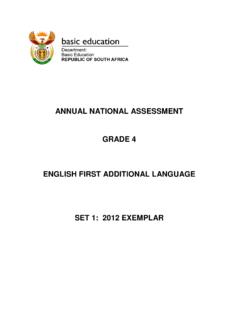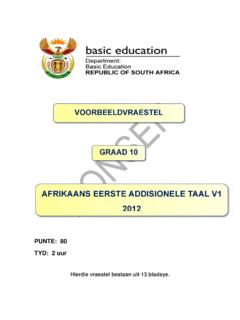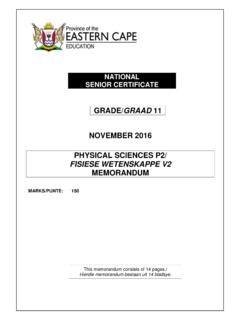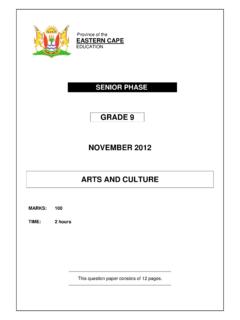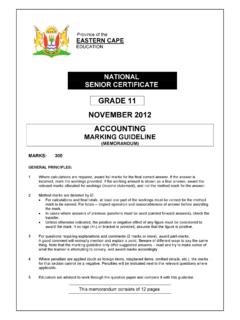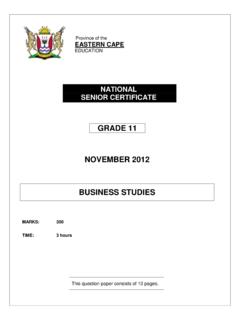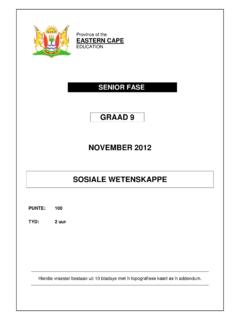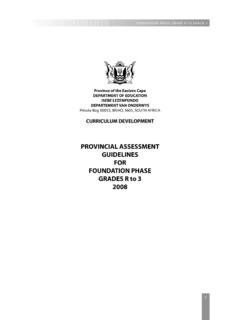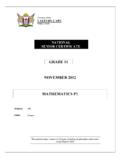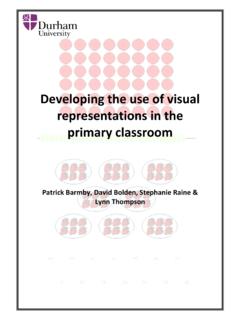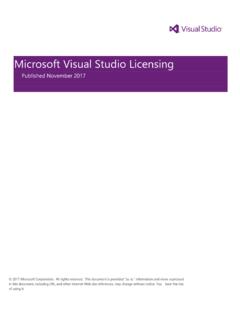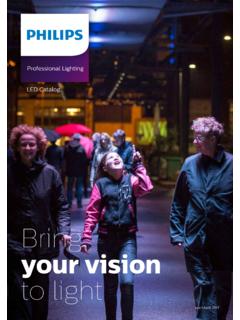Transcription of GRADE 11 NOVEMBER 2012 VISUAL ARTS P1
1 Province of the EASTERN CAPE. EDUCATION. NATIONAL. SENIOR CERTIFICATE. GRADE 11. NOVEMBER 2012 . VISUAL arts P1. MARKS: 100. TIME: 3 hours *VISDM1*. This question paper consists of 23 pages. 2 VISUAL arts P1 ( NOVEMBER 2012 ). INSTRUCTIONS AND INFORMATION. 1. There are TEN questions in this question paper. 2. Answer FIVE questions of your choice. 3. Read the questions carefully. 4. Answer in full sentences and use paragraphs. DO NOT USE POINT. FORM. 5. Use the mark allocation to determine the time to be spent on each question. Each question should take about 35 minutes. 6. Write neatly and legibly. 7. In this exam you will be expected to demonstrate the following: The use of correct terminology The use of VISUAL analysis and critical thinking Writing and research skills within a historical and cultural context The placing of examples into a social and historical context An understanding of distinctive artistic styles The identification of the professional practice of local artists ( NOVEMBER 2012 ) VISUAL arts P1 3.
2 GLOSSARY. Analyse: A detailed and logical discussion of the formal elements (such as line, colour, tone, format, et cetera) and composition of the work, with insightful comments about why and how it succeeds. Compare: Point out, sentence by sentence, the differences and similarities in an ordered sequence within the same argument. Discuss: Present your point of view and give reasons for your statements. Explain: Clarify and give reasons for your statements. Interpret: Give an informed opinion, supported by examples. State: Say directly what you think give your opinion as well as an explanation. Evaluate: Point out the RELEVANT positives, negatives, elements and principles of the work and give some evaluative comment about why and how it succeeds or not, in the broader picture of art history in general, you need to be able to see the big picture of world art to make evaluative comments.
3 4 VISUAL arts P1 ( NOVEMBER 2012 ). QUESTION 1. ART AND PROPOGANDA. Refer to FIGURE 1a. Marat was a French revolutionary, who was killed in his bath, while writing a letter to his compatriots about the Revolution. Discuss the ways in which David has succeeded in portraying this dramatic event. Refer to the elements of art as well as compositional effects. (5). Over the decades, with different governments in power in South Africa, the struggle for freedom of the press has been an issue many times. By evaluating these two posters in FIGURE 1b and 1c, from an artistic point of view, show how artists make propaganda reach the minds of people. Refer to colour, line, textures, imagery and structural layout. (6). Choose TWO works about art and propaganda which you have studied. They may be South African or International. Discuss these works using the bullets as your guide: Name titles of the works, together with the artists' names Subject matter of the works and the messages in this Use of colour and line, and the effects on the works (9).
4 [20]. ( NOVEMBER 2012 ) VISUAL arts P1 5. FIGURE 1a: Jacques Louis David. Death of Marat. 1793. FIGURE 1b FIGURE 1C. FIGURES 1b and 1c: Two posters dealing with freedom of the press. 1989. 6 VISUAL arts P1 ( NOVEMBER 2012 ). QUESTION 2. MONUMENTS AND HERITAGE SITES. Refer to Figures 2a, 2b and 2c. Analyse the similarities among these three monuments. (2). Define the most striking VISUAL element of each one, and in each case, state with justification what you think the artist/designer wanted to say to posterity. (6). Comment on how the scale in these three examples reflects a message as you see it. (2). Choose any TWO OTHER monuments you have studied. Name them and compare them in terms of the following: Materials used and the impact of these Subject matter and features of the monuments The messages of the monuments How masses/volumes interact with voids or surrounding space and the effect on the viewer (10).
5 [20]. Glossary: Posterity = those who come after you. Future generations. ( NOVEMBER 2012 ) VISUAL arts P1 7. FIGURE 2a: Easter Island figures. Artist unknown. Ancient FIGURE 2b: Stonehenge. Wiltshire. England. Ancient FIGURE 2c: Freedom Park. Salvokop. Transvaal. Contemporary 8 VISUAL arts P1 ( NOVEMBER 2012 ). QUESTION 3. INTERNATIONAL TRENDS: IMPRESSIONISM AND POST IMPRESSIONISM. In the last quarter of the 1800s, the art world in France and Europe underwent radical changes. Impressionism was a fresh new direction. Refer to FIGURE 3a and the work of TWO other artists you have studied. Write an essay of one and a half pages on Impressionism. Pay attention to the influences on this Movement, the stylistic characteristics, the subject matter and how artists treated light and colour. (10). Post Impressionism showed a more individualised approach.
6 By referring to FIGURE 3b, critically analyse this work by Gauguin as a Post- Impressionist work. Refer to the following: Influences on Gauguin Treatment of space Treatment of shapes Treatment of colour Use of line (10). [20]. ( NOVEMBER 2012 ) VISUAL arts P1 9. FIGURE 3a: Claude Monet. Impression Sunrise. 1872. FIGURE 3b: Paul Gauguin. Day of the gods. 1890. 10 VISUAL arts P1 ( NOVEMBER 2012 ). QUESTION 4. CUBISM, FAUVISM, FUTURISM AND EXPRESSIONISM. Write an essay of a minimum of two pages in which you attend to the bullets below. You may use the illustrated works as substantiation, but you will receive extra marks if you refer to other works you have studied from these four movements. In your essay, do each movement separately, before moving on to the next Movement. Explain the influencing factors that gave rise to each movement Describe TWO characteristics of style of each movement Substantiate all the way Give commentary on the compositional arrangements and your ideas about the effect of these arrangements (20).
7 [20]. ( NOVEMBER 2012 ) VISUAL arts P1 11. FIGURE 4a: Irma Stern. FIGURE 4b: FIGURE 4c: Eternal Child. 1916 Giocoma Balla. Georges Braque. Street light. Man with guitar. FIGURE 4d: Irma Stern. FIGURE 4e: Henri Matisse. Flight. Oil. 1950 Portrait of Madame Matisse. 1905. 12 VISUAL arts P1 ( NOVEMBER 2012 ). QUESTION 5. GALLERY VISITS AND EXHIBITIONS. At an exhibition of successful International and South African artists, the four works FIGURES 5a, 5b, 5c and 5d were selected as being relevant statements about the realities of our world. Observe the works illustrated for this question, and write an essay of one page in which you pay attention to the following: Social message of each work How colour plays a role in referring to a wider social and/or political awareness for the viewer Your evaluation of the current value of these works, both financially and socially (10).
8 Write an essay of one and a half pages in which you describe the subject matter and public appeal of any TWO international and TWO South African works you have studied. Do NOT choose works from this or any other question on this exam paper. (10). [20]. Glossary: Prosperine = a mythical ancient Roman goddess, who was stolen because of her beauty to live with Pluto in the underworld. Her story is tied up with spring. She ate four pomegranate seeds, and this enabled her to live with her mother in the real world for three seasons of the year, but then she had to go back to the underworld to Pluto for winter. The Greek goddess for spring was known as Persephone. Prosepere means to emerge. ( NOVEMBER 2012 ) VISUAL arts P1 13. FIGURE 5a: FIGURE 5b: Willem de Kooning. Woman IV. Dante G. Rossetti. Oil. 1954. Prosperine. 1874. FIGURE 5c: Edvard Munch.
9 Dance of Life. FIGURE 5d: Helen Sebidi. Mother Africa. 1884 1981. 14 VISUAL arts P1 ( NOVEMBER 2012 ). QUESTION 6. FORMAL AND INFORMAL SCHOOLS IN SOUTH AFRICA. Write an essay in which you explore the purposes, artists' works, subject matter and social messages of ONE of the Informal Schools in South Africa that you have studied. You may use any of the artists you have studied from the chosen school, but you may not discuss the works provided for this question. (10). Refer to FIGURES 6a, 6b, 6c and 6d Compare how the three artists have depicted animals in these works. Refer especially to line, forms, textures and overall composition. (8). In your opinion, which of the four works, 6a, 6b, 6c and 6d, is the most evocative? Say what your chosen work evokes, and give ONE fact to substantiate your answer. (2). [20]. ( NOVEMBER 2012 ) VISUAL arts P1 15.
10 Ezrom Legae Horse rider 1970 Cyprian Shilakoe My donkey 1970 woodcut 30,5 x 25 cm FIGURE 6a: Ezrom Legae. Horse Rider. FIGURE 6b: Cyprian Shilakoe. My donkey. 1970 1970. FIGURE 6c: Petros Gumbi Ardmore. FIGURE 6d: Sydney Kumalo. Spider and Giraffe. 2007 Fallen Horse. Bronze sculpture. 1988. 16 VISUAL arts P1 ( NOVEMBER 2012 ). QUESTION 7. WESTERN INFLUENCES ON SOUTH AFRICAN ART. Refer to FIGURES 7a, 7b and 7c. Define concisely, by referring to TWO. aspects per work, how these examples have shown influence by Western and European art movements. Be sure that you name each Western Art Movement. (6). Compare FIGURE 7a with 7b. Use the following pointers to assist you: Imagery and messages Composition and how it makes the VISUAL appreciation good or not The emotional impact of style (8). Refer to Preller's Hieratic Women in FIGURE 7c.
